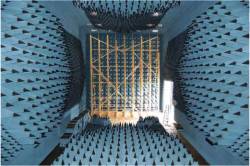A GNSS signal simulator is mainly used to simulate GNSS signals transmitted by navigation satellites, propagated through the Earth’s atmosphere, and received by the receiver antenna. A simulator provides a convenient signal source for the test and validation of receiver function and performance and can also be used in GNSS experiments and studies of signal/data processing algorithms.
A GNSS signal simulator is mainly used to simulate GNSS signals transmitted by navigation satellites, propagated through the Earth’s atmosphere, and received by the receiver antenna. A simulator provides a convenient signal source for the test and validation of receiver function and performance and can also be used in GNSS experiments and studies of signal/data processing algorithms.
A simulator supports controllable and repeatable tests without considering the availability of real satellite signals. Finally, it also allows tests with non-on-orbit satellites, high dynamic, indoor or other critical/specific conditions. Examples of commercial GNSS simulator specifications and articles describing typical applications can be found in the Additional Resource section near the end of this article.
As a key type of test equipment, the GNSS simulator itself needs to be tested extensively to verify that it meets rigorous technical specifications. Although the design of a high-fidelity GNSS RF (radio frequency) signal simulator with capabilities for multi-constellation, multi-signal-structure, multi-channel, and multi-level–output simulation is very challenging, the verification testing of such a simulator could be much more difficult than conducting similar tests for a GNSS receiver.
A GNSS simulator has higher requirements for accuracy, precision, stability, range and resolution, not to mention the lack of well established receivers of new constellations and new signals that could be used in verification testing. This is one of the reasons that few publications are found to explore the issue of simulator testing. The articles by A. Tetewsky et alia, P. Boulton et alia, and G. Heinrichs et alia listed in Additional Resources provide a few examples of such testing.
In order to support the design and validation of new GNSS constellations and signals as well as the corresponding monitoring equipment and receiver components, our group in Beihang University has developed a fully functioning GNSS constellation simulator capable of real-time simulation of more than 10 kinds of Compass/GPS/Galileo RF signals. One issue raised here is how to prove its qualification for the performance parameters.
After a brief description of its technical characteristics, this article focuses on the verification testing methodology of GNSS RF signal simulators using signals from a variety of constellations. Extensive tests are carried out at the following four levels: analog IF (intermediate frequency)/RF signals, baseband signals, measurements and demodulated navigation messages, and position solutions.
Multi-level measurements of the signal quality are obtained by using a signal quality assessment system incorporating standard instruments, multi-GNSS software receivers, and specialized analysis software with unique signal/data processing techniques to improve observability and measurement accuracy.
Technical Characteristics of the Multi-GNSS Signal Simulator
Two main elements comprise the Beihang University multi-GNSS RF signal simulator: the upper-computer simulation software and the hardware signal generator. The signal generator performs real-time analog IF/RF signal synthesis and includes a synchronization control card, IF signal modulation cards, RF up-conversion and conditioning cards, and RF combining cards. All these cards are mounted as peripheral modules in a PXIe (PXI Express) bus chassis, as described in the patent by Y. Kou et alia (2009) cited in Additional Resources.
The upper-computer simulation software performs modeling, signal parameter computation, simulation control, and GUI (graphical user interface). Depending on the computation load, the software can run on the platform of either an embedded PXIe controller mounted on the No. 0 slot of the chassis or a cableconnected PC. The new PXIe specification integrates PCIe (PCI Express) signaling into the PXI standard aiming at instrumentation systems, which provides increased bandwidth, extra timing and synchronization mechanism while ensuring backward compatibility.
The modular architecture based on software radio enables the user to define the combination of constellations, carriers, signals, and interferences to be simulated at will. In addition, the signal generator applies low-IF digital quadrature modulation that can accommodate signals with different structures. So, this design makes it very convenient to increase or decrease the number of simulated constellations and signals, as well as change the signal modulation to support the future signal structures while maintaining the accuracy, resolution, stability, and dynamic range.
Figure 1 (above) shows one configuration of our simulator, which can generate signals on six carrier frequencies simultaneously. The chassis can accommodate up to 10 carriers, with each three-card module generating signals on two carriers in our design. The signal generator can be conveniently integrated with other modular measurement instruments while a specially designed synchronization control card and RF signal- combining card support seamless extension of the multi-chassis.
Other characteristics of the simulator include:
1. Multi-level output: providing baseband data, analog IF signal, and RF signal output simultaneously to facilitate multi-loop test and receiver troubleshooting
2. Multi-constellation navigation data and multi-structure signal simulation: supporting multi-frequency/ multi-system/multi-mode integration navigation experiments and receiver tests
3. Two-level power control: wide range power control of the RF/IF signals for all the simulated space vehicles (SVs)
4. High dynamic, variable interference, and multipath simulation: various user dynamics simulation using a common trajectory generation method, CW (continuous wave) /narrow-band /wide-band /sweptfrequency interferences generation with controllable parameters on different center frequencies, multipath modeling and error envelop testing
5. Real-time simulation: real-time signal calculation and generation of unlimited time length
6. Observability: various intermediate outputs for test and analysis of physical signals, measurements, and navigation solutions
7. Controllability: definable and repeatable simulation scenarios, optional signal formats, configurable parameters including error models, combination of signals and interferences, signal/interference parameters, trajectory dynamics, SV shielding angle, constellation, ephemeris source, and so forth.
Four-Level Verification Testing
For an effective test of the corresponding receiver performance, signals generated by a simulator should have much higher accuracy, precision, stability, resolution, and wider range, as can be checked in the simulator’s technical specifications. Generally, the simulated signals are spreading signals buried in the thermal noise, which are difficult to be characterized using regular measurement techniques.
. . .
Analog IF/RF Signals
The analog IF/RF output signals of the simulator can be sent to various standard instruments . . . To minimize the measurement error caused by thermal noise, the instrument input SNR (signal to noise ratio) is typically required to be higher than 20 decibels.
The analog IF output of our simulator reaches up to -43dBW, which can be tested directly. Most simulators provide a calibration/monitoring port for high-power–level RF signal output. For example, the power level of the calibration port of our simulator is 40 decibels higher than the nominal RF signals.
. . .
Baseband Signals
The standard instrumentation is only capable of measuring communication system–related parameters of the IF/ RF signals specialized for the test case. It cannot measure parameters showing the distortion effects on navigation performance. Nor can it measure the signals with nominal RF power level or under dynamic scenarios.
To solve this problem, we propose a customized GNSS signal-quality assessment system based on high-speed data acquisition equipment, a multi-GNSS software receiver, and a baseband signal analysis software …
. . .
Measurements and Navigation Data
Our simulator can record the power level, propagation delay, each ranging error, navigation data, or other parameters of the simulated GNSS signals. A receiver capable of processing the corresponding signals can estimate the C/N0, pseudorange, carrier Doppler, and carrier phase of each SV signal, or record the demodulated navigation data. Thus, we can verify the correctness of the signal/data simulation.
Using specific test scenario configurations and specific data processing, we can even evaluate the accuracy and range of some parameters of the signals generated by the simulator. To eliminate the effects of extra clock error, clock drift, and frequency drift, the receiver or the signal collecting equipment should use a clock reference coherently derived from the simulator clock reference.
. . .
Navigation Solutions
The navigation solutions enable a general assessment of the overall performance of the simulator … The results validate the correctness of the simulated navigation data (in GPS NAV format for the time being) and L1C signals.
. . .
Conclusions
The four-level verification testing methodology is not limited by the internal implementation of various simulators. It enables a direct test of RF/IF output, which reduced the testability design requirements of simulators, and thus is more applicable and operable than white-box testing. The method provides an accurate multi-level description of the signal quality.
The signal quality assessment system that we have developed can measure not only typical communication system– related parameters but also signal distortions affecting navigation performance. By applying special signal/data processing techniques to improve signal observability and measurement accuracy, we can characterize not only the high-power–level zero-Doppler test signals but also the normal dynamic signals buried in thermal noise.
A possible extension of this work is to further explore methods for testing various aspects of the technical performance of GNSS signal simulators, including both essential mathematical analysis and extensive experimental validation.
For the complete story, including figures, graphs, and images, please download the PDF of the article, above.
Acknowledgement
This article is based on a paper presented at the 2nd China Satellite Navigation Conference (CSNC 2011) held May 18–20, 2011, in Shanghai, China.
Additional Resources
[1] Artaud, G., and A. de Latour, J. Dantepal, L. Ries, Maury, N., Denis, J.-C., Senant, E., Bany, T., “A New GNSS Multi Constellation Simulator: NAVYS,” Proceedings of the 23rd International Technical Meeting of The Satellite Division of the Institute of Navigation (ION GNSS 2010), Portland, OR, September 2010, pp. 845–857
[2] Berglez, P., and E. Wasle, J. Seybold, and B. Hofmann-Wellenhof, “GNSS Constellation and Performance Simulator for Testing and Certification,” Proceedings of the 22nd International Technical Meeting of The Satellite Division of the Institute of Navigation (ION GNSS 2009), Savannah, GA, September 2009, pp. 2220–2228
[3] Boulton, P., and A. Read, and R. Wong, “Formal Verification Testing of Galileo RF Constellation Simulators,” Proceedings of the 20th International Technical Meeting of the Satellite Division of The Institute of Navigation (ION GNSS 2007), Fort Worth, Texas, September 2007, pp. 1564–1575
[4] Han, L., and Y. Kou, “Simulation and assessment of GPS signal quality degradation caused by satellite hardware failures”, Proceedings of SCIRP CPGPS 2010, August 18–20, 2010, Shanghai, China
[5] Heinrichs, G., and M. Irsigler, R. Wolf, and G. Prokoph, “Performance Evaluation of the Multi-Constellation and Multi-Frequency GNSS RF Navigation Constellation Simulator NavX-NCS,” Proceedings of the 21st International Technical Meeting of the Satellite Division of The Institute of Navigation (ION GNSS 2008), Savannah, GA, September 2008, pp. 1237–1241
[6] http://www.castnav.com/cast_pdf/cast_2000.pdf
[7] http://www.ifen.com/content/flyer/NavX-NCS-PRO-Datasheet_ July2010.pdf
[8] http://www.spirent.com/Solutions-Directory/~/media/Datasheets/ Positioning/GSS8000.ashx
[9] Kou, Y., (2008), and B. Zhang, and Y. Zhao, “Design and Implementation of a Multi-Signal-Structure GNSS Signal Simulator Using Low IF Digital Quadrature Modulation”, Proceedings of the 21st International Technical Meeting of the Satellite Division of The Institute of Navigation (ION GNSS 2008), Savannah, GA, September 2008, pp. 2677–2691
[10] Kou, Y. (2009), and H. Liu, H. Zhang, B. Yu, and Z. Wang, “Method and Apparatus for Implementation of a GNSS Signal Simulator Based on PXIe Bus,” Chinese patent No. 200910238050.2, 2009
[11] Kou, Y. (2010) and X. Zhou, Y. Morton, and D. Akos, “A Software-Based Receiver Sampling Frequency Calibration Technique and its Application in GPS Signal Quality Monitoring,” Proceedings of IEEE/ION PLANS 2010, Indian Wells, California, USA, May 2010, pp. 718–727
[12] Kou, Y., and Z. Ma, B. Zhang, Q. Zhang, and J. Zhang, “Common navigation satellite signal interference and signal generation method”, Chinese patent No. 200810117348.3, 2008
[13] Li, R., and D. Zeng, T. Long, and L. Zhang, “Architecture and Implementation of a Universal Real-Time GNSS Signal Simulator,” Proceedings of the 2010 International Technical Meeting of The Institute of Navigation, San Diego, California, USA, January 2010, pp. 1037–1043
[14] Liu, H., and Y. Kou, “Design and Implementation of a GNSS Signal Collection System Using Direct RF Sampling”, Proceedings of IEEE Prime Asia 2009, Shanghai, China, Nov. 19–21, 2009
[15] Liu, Q., and Y. Kou and H. Zhou, “Design and Implementation of a Real-time L2C IF Signal Simulator,” Proceedings of IEEE ICISE 2010
[16] National Instruments Corporation, NI PXIe- 1075 User Manual, July 2008
[17] Pini, M., and D. Akos, “Exploiting GNSS Signal Structure to Enhance Observability,” IEEE Transactions on Aerospace and Electronic Systems, VOL. 43(4), October 2007, pp. 1553–1566
[18] PXI Systems Alliance, PXI-5 PXI Express Hardware Specification, Revision 1.0
[19] Tetewsky, A., and A. Soltz, D. Fuhry, G. Barton, D. Eyring, B. Goossens, M. Dodds, and L. Fava, “Validating the Validating Tool: Defining and Measuring GPS Simulator Specifications,” Proceedings of the 10th International Technical Meeting of the Satellite Division of The Institute of Navigation (ION GPS 1997), Kansas City, Missouri, USA, September 1997, pp. 1681-1695
[20] Yang, W., and Y. Zhao, Y. Kou, and Z. Huang, “Modeling of GPS multi-path signals and receiver testing,” Journal of Beijing University of Aeronautics and Astronautics, 2009,V35(5): pp. 551-554
[21] Zhao, Y., and Y. Kou, Z. Huang, and Q. Zhang, “A Common trajectory generation method of three-dimensional vector for GNSS simulator,” Chinese patent No. 201010296636.7, 2010




